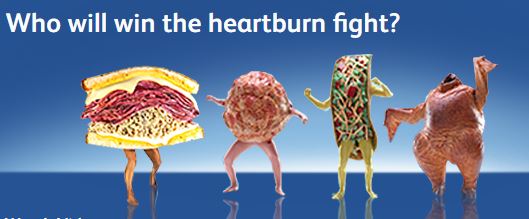You may have seen this hilariously strange new ad for Tums Smoothies during the political convention season (2016) on TV. If so, you’ve “Felt the (Heart)Bern” in a way that probably made you do a double-take the first time you saw it:
A pack of naked hot dog people, attacking a lone male camper in the woods? Shiny long sausages, tackling him to the ground? You don’t have to be Freudian to see that this obviously is a phallic nightmare. In fact, the obviousness of that latent subtext is so much in the foreground, that it may even occlude the overt message here: the ad’s “narrative” is suggesting that you should not attempt to eat a whole “pack” of “dogs” when you go camping, else they will get their revenge on you. But if you do…Tums can shield and protect you from the heartburn pain.
The return of the repressed is a kind of acid reflux — you ate something you should not have, and it has come back to haunt you. What makes all this uncanny is that the symbolism of the “dog” is literalized, in the way the commercial depicts this food as animal. The dogs “bark at the moon” in the stunning opening shot, where a crouching nude body stands in contrast to an unusually large full moon, with all the sexual repression latent in the way it’s showing his “buns.” This is the stuff of not only Sigmund Freud, but also werewolf literature, and not acid reflux remedies…but in the magic system of advertising, all commercial products — from foods (Pillsbury Doughboy) to batteries (Energizer Bunny) — can be living creatures, like something possessed with the power they want you to believe the product has… akin to something supernatural. This is what is meant by commodity fetishism: attributing supernatural agency to consumer goods, and reifying the systems of production that can magically solve all your everyday problems.
But unlike the usual supernaturalization of product spokesmen (like we get with many other medications, like the “gut man” for Xifaxan — here’s a good commercial example), Tums doesn’t give us some magical walking “tummy”. Instead the disturbing creatures are foods that are aggressive and hostile and must be vanquished. The Hot Dog commercial cited above is but one of a series of “Food Fight” advertisements from Tums antacid that treat foods as large (clearly costumed) ambulatory creatures. Other ads show headless dead chickens, belligerent tacos, bullish T-Bones, and feisty little Italian meatballs. In every case, consumers must defend themselves from food that attacks them, and the tablets of Tums are framed as a kind of magical shield. The man in the Hot Dog commercial literally holds a “torch” in one hand and the tiny Tums Smoothies package in the other before him, the way Van Helsing holds up a torch and a cross to keep a vampire at bay!

The ad condenses its narrative so swiftly that there are some disjunctive cuts — in one shot, “when heartburn comes creeping up on you,” the camper is tackled and overtaken by the pack of dogs, who seem to scrabble over his groin; then a cut shows him on his feet, holding the Tums jar aloft to chase them away. As we try to put together what just happened in the gap across the cut, which has all the suggestion of a kind of rape, if not murder — the advertisement switches into “scientific demonstration” mode to offer an explanation: through animation, it shows a dissolving tablet morphing into ghost-like magic tendrils that encircle the pain and sphinctering in on flames to extinguish them; the voiceover claims this is how the antacid “neutralizes stomach acid at its source.” Afterward, the medicated man blows out his hot dog stick-slash-torch, symbolically blowing out the “burn” of said stomach acid with a satisfied smile. Then the infamous “tum-ta-tum-tum” chorus closes out the ad. Importantly, this jingle is reminiscent of the Dragnet theme, associating the product in our cultural memory with a power akin to the “protectors” from law enforcement or the shield of the police, and, playing out over the image of the Tums logo and Smoothies product, it gets the final say.

While these Tums commercials are all about force, battle and aggression, they are uniformly framed as “defensive” actions, projecting the conservative impulse to “protect” ourselves from a threat. Often in ads, these threats are associated with abstractly gendered, sexual tensions — from the meatballs and steaks that interrupt men on a date, challenging their masculinity, to the virtual gang rape of a man by ambulatory phalluses while alone in the woods. (It is interesting to contrast this against the Tums Taco advert, where the less phallic, more yonic, Taco tackles women — until one picks up a guitar and beats the Mexican entree, ending in a liberated, libidinal Mariachi dance).
These commercials are depicting “monster battles” and the more one thinks about the way they really are treating food as limbless, eyeless, headless creatures the more nightmarish they might become. But what they are really doing is representing these edible Others as containable threats, for they are human, but “less than human.” This manages to counterbalance the weirdness of monstrous bodies against the realm of comedy, resulting in an unsettling but chuckle-worthy sense of uncanniness. (Contributing to the unsettled nature of this is our repressed awareness that what we eat is also something that once lived — other animals, who once lived and breathed just like us — organic forms whose bodies have been sacrificed and repurposed into objects for our consumption (and then in these ads, monstrously reborn all over again as part-human, part-entree hybirds). The humor is enacted by virtue of excessive and ludicrous imagery, the mode of parody in the Dragnet and Dracula references, and even the babytalk inherent to the product’s naming: Tums “Smoothies.” A “smoothie” is typically an organic fruit drink, not a chemical heartburn remedy, so this over-the-counter product still aligns itself with consumerism by virtue of naming its medicine as a kind of comfort food. And the term “tum” (or “tummy”) is clearly a childish way of saying “stomach.” This reassurance is regressive: it’ll all be okay in your tum-ta-tum-tum, after all, poor child-adult. Just pop this chewable pill….
In the end we are assured by the domestic comedy, and the restoration of these animistic beliefs from childhood, that these supernatural agents are harmless and that this is all just in good fun. Reassurances often take the structure of psychological disavowal when they circulate in advertising. This dreamwork logic disavows, occludes, and obfuscates the very real issue at the root of it all: that consumerism itself is often to blame for all this ulcerating acidity in the first place, and that heartburn medicine offers a “quick fix” mostly so that you can continue to over-indulge. These comical narratives are not just stories about putting the acid reflux in remission, but are stories about the power of the consumer product to repress guilt over unconscious desire, in order that we might indulge our fantasies and consume all over again, even when we consciously know that what we are doing might be harmful and “come back to haunt us” later. They perfectly embody the popular uncanny.
